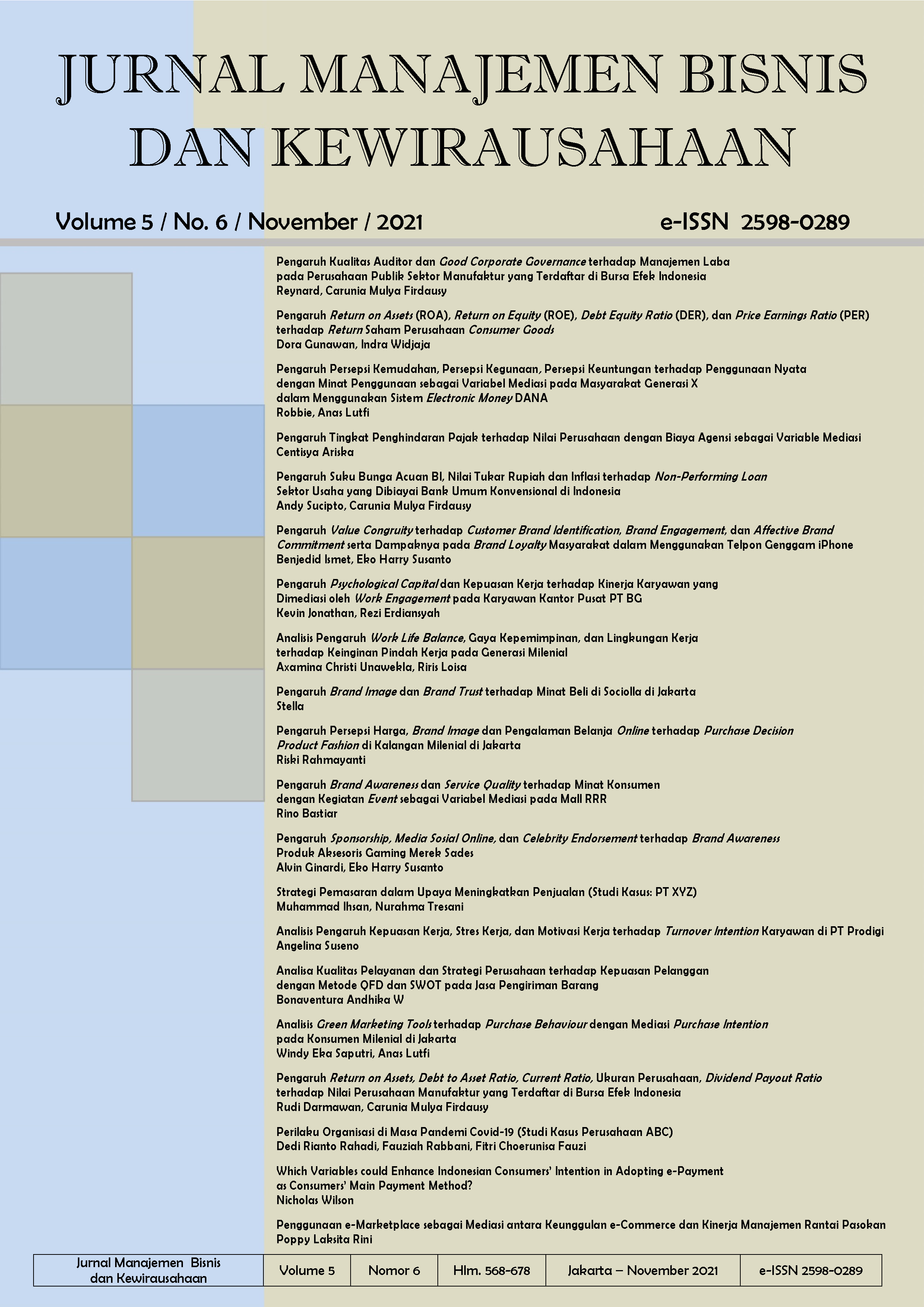Which Variables could Enhance Indonesian Consumers’ Intention in Adopting e-Payment as Consumers’ Main Payment Method?
Main Article Content
Abstract
This study was commenced to fully understand the impact that was given by both Security Risk and Perceived Usefulness in strengthening or enhancing Consumers' Intention to adopt or use E-Payment services as their main payment method every time consumers are conducting any buying or transactional activities toward any stores (either online stores or offline store) which they've visited. Implementing survey method, questionnaires were chosen and implemented as the main tools to collect and gather all of the required data from the respondents. A total of 200 respondents participated in this study, which, all of the respondents who participated in this study are those who've chosen and used E-Payment as their main payment method when they're conducting any transactional buying activities on any stores at least 5 times for the past 1 year. All of these data then were further analyzed, in which author would like to conclude that all of these data were valid, reliable, and usable to be further processed in this study. Using PLS-SEM as the main method in analyzing and processing all of the data gathered in this study, the author would like to conclude that both Security Risk and Perceived Usefulness have a significant impact on Indonesian Consumers' Intention to adopt E-Payment services as their main payment method for any transactional activities conducted by the consumers.
Studi ini dilakukan guna mengetahui bagaimana pengaruh yang diberikan oleh Security Risk dan Perceived Usefulness terhadap Intensi Konsumen Indonesia di dalam mengadopsi serta menggunakan E-Payment sebagai metode pembayaran yang dipilih setiap kali konsumen melakukan transaksi pembelian produk ataupun jasa pada suatu toko tertentu. Adapun dengan menggunakan ataupun mengimplementasikan metode survei, penelitian ini menggunakan Kuesioner sebagai alat yang akan digunakan untuk mengumpulkan seluruh data yang diperlukan dari seluruh responden yang berpartisipasi pada studi ini. Sebanyak 200 responden berpartisipasi pada studi ini, yang dimana, seluruh responden merupakan Konsumen Indonesia yang pernah menggunakan E-Payment sebagai metode utama mereka di dalam melakukan berbagai aktivitas pembayaran atas transaksi yang dilakukan paling sedikit 5 kali dalam kurun waktu 1 tahun terakhir. Adapun setelah melakukan pengecekan secara menyeluruh terhadap seluruh data yang terkumpul, peneliti dapat menyimpulkan bahwa seluruh data yang terkumpul pada penelitian ini merupakan data yang valid, reliable serta dapat diproses secara lebih lanjut pada studi ini. Dengan menggunakan PLS-SEM sebagai metode pengolahan data yang dipilih pada studi ini, peneliti dapat menyimpulkan bahwa kedua variabel, yaitu Security Risk serta Perceived Usefulness berpengaruh signifikan terhadap Intensi Konsumen Indonesia di dalam mengadopsi serta menggunakan sistem E-Payment sebagai metode pembayaran utama yang dipilih ketika konsumen melakukan transaksi pembelian.
Article Details
This work is licensed under a Jurnal Manajemen Bisnis dan Kewirausahaan Creative Commons Attribution-ShareAlike 4.0 International License.
References
Ariffin, S. K., Mohan, T., & Goh, Y. N. (2018). Influence of consumers’ perceived risk on consumers’ online purchase intention. Journal of Research in Interactive Marketing, 12(3), 309–327. https://doi.org/10.1108/JRIM-11-2017-0100
Nurhayati-Wolff, H. (2021). Share of e-payment users among respondents in Indonesia in 2020. Statista.Com. https://www.statista.com/statistics/1105688/indonesia-share-of-e-payment-users/
Shiau, W. L., Yuan, Y., Pu, X., Ray, S., & Chen, C. C. (2020). Understanding fintech continuance: perspectives from self-efficacy and ECT-IS theories. Industrial Management and Data Systems, 120(9), 1659–1689. https://doi.org/10.1108/IMDS-02-2020-0069
Stocchi, L., Michaelidou, N., & Micevski, M. (2019). Drivers and outcomes of branded mobile app usage intention. Journal of Product and Brand Management, 28(1), 28–49. https://doi.org/10.1108/JPBM-02-2017-1436
Trinh, H. N., Tran, H. H., & Vuong, D. H. Q. (2020). Determinants of consumers’ intention to use credit card: a perspective of multifaceted perceived risk. Asian Journal of Economics and Banking, 4(3), 105–120. https://doi.org/10.1108/ajeb-06-2020-0018
Wilson, N. (2019). The impact of perceived usefulness and perceived ease-of-use toward repurchase intention in the Indonesian e-commerce industry. Jurnal Manajemen Indonesia, 19(3), 241–249. https://doi.org/10.25124/jmi.v19i3.2412


